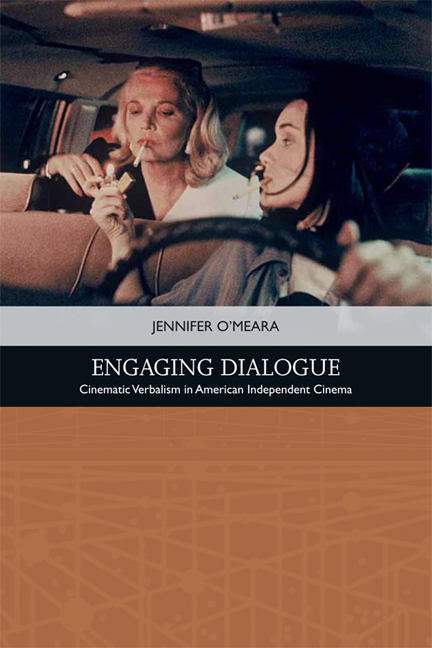Book contents
- Frontmatter
- Contents
- List of Figures
- Acknowledgements
- Introduction
- 1 Measuring Engaging Dialogue
- 2 Verbal-Visual Style and Words Visualised
- 3 The Integrated Soundtrack and Lyrical Speech
- 4 Dialogue and Character Construction
- 5 Embodying Dialogue: Rich Voices, Expressive Mouths and Gesticulation
- 6 Gendered Verbal Dynamics: Sensitive Men and Explicit Women
- 7 Adapting Dialogue and Authorial Double-voicing
- Conclusion: Verbal Extremes and Excess
- Filmography
- Bibliography
- Index
Conclusion: Verbal Extremes and Excess
Published online by Cambridge University Press: 01 May 2021
- Frontmatter
- Contents
- List of Figures
- Acknowledgements
- Introduction
- 1 Measuring Engaging Dialogue
- 2 Verbal-Visual Style and Words Visualised
- 3 The Integrated Soundtrack and Lyrical Speech
- 4 Dialogue and Character Construction
- 5 Embodying Dialogue: Rich Voices, Expressive Mouths and Gesticulation
- 6 Gendered Verbal Dynamics: Sensitive Men and Explicit Women
- 7 Adapting Dialogue and Authorial Double-voicing
- Conclusion: Verbal Extremes and Excess
- Filmography
- Bibliography
- Index
Summary
In order to thoroughly consider engaging dialogue in American independent cinema, this book has analysed the design and execution of the work of six contemporary writer-directors from a variety of perspectives. By coining and developing the term ‘cinematic verbalism’, I underscore how dialogue can be central to the working and effect of independent cinema, without necessarily overshadowing the more medium-specific components (such as the sound and image tracks), as tends to be assumed when dialogue is classified as a ‘literary’ device. Instead, Wes Anderson, Noah Baumbach, Hal Hartley, Jim Jarmusch, Richard Linklater and Whit Stillman use speech in such ways that it gains impact through the specifics of the medium.
Focusing on the relationship between their dialogue and other components of their work (and areas of film studies more generally) has established the importance of dialogue analysis to studies of: the soundtrack, visual style, character, performance, gender and adaptation, as well as reception and auteur studies. Taking an audience-focused approach has then allowed for an exploration of the ways each cinematic verbalist's dialogue can perceptually and cognitively engage us. Their speech is generally written, performed, recorded and integrated in such ways that audiences construct meaning by joining the dialogue dots, or filling the dialogue blanks. Individual lines are rarely memorable in a way that would earn them a place on the American Film Institute's ‘100 Movie Quotes’ (2005), a list compiled by a jury of filmmakers, critics and historians on the basis of cultural impact (measured by a line of dialogue's quotability) and legacy (its ability to evoke memories of the film). This is not a weakness of such independent film dialogue, but the outcome of speech that is carefully entwined with their films’ various components. The remembering and repetition of specific lines by audioviewers is uncommon in these cases precisely because the language accumulates meaning through its execution in the finished film. Instead, their dialogue operates on complex levels that allows for alternative forms of audience pleasure. Overall, their dialogue can be characterised by: (1) alternations between verbal efficiency and excess; (2) ‘gaps’ in verbal meaning; and (3) the reflexive, exaggerated treatment of mainstream dialogue norms. In various ways, the cinematic verbalists’ dialogue is both more stylised and more naturalistic than that of generic dialogue. As a result, it draws attention to ways that generic dialogue is also stylised, but in less overt ways.
- Type
- Chapter
- Information
- Engaging DialogueCinematic Verbalism in American Independent Cinema, pp. 176 - 188Publisher: Edinburgh University PressPrint publication year: 2018



